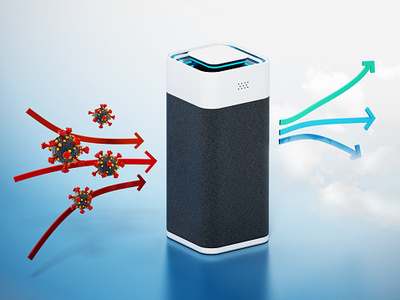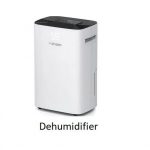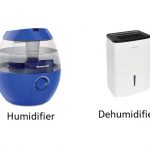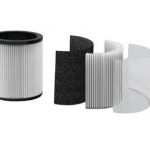What are air purifiers for?
You might have come across an air purifier for the first time or someone has recommended using one. Well, hearing about an air purifier for the first time may trigger various questions. One may wonder what air purifiers are for?
Today, there has been an increasing concern over air pollution in many households. Doctors now recommend the use of air purifiers. Probably, this might be the reason why you are asking yourself why you need one.
Air purifiers have multiple roles that make them vital for homes. They are one of the best and most reliable ways of improving air quality. They remove airborne impurities to enhance your well-being.
To help you understand the uses of air purifiers, we have provided useful details regarding air purifiers. We hope this information can help you understand what air purifiers are and the benefits of using one.
What Are Air Purifiers?
Before answering what air purifiers are used for, let us first discuss what they are.
Air purifiers are electronic devices that are used to remove airborne pollutants to improve indoor air quality. They come in different sizes and capacities. Their cost also vary with capacity.
Depending on the model, these air purifiers use various filtration technologies. These include pre-filter, HEPA filter, carbon filter, UV light, and ionizers. Each of these filters has specific pollutants they can capture. So, the more filters an air purifier has, the more effective it is.
How Effective Are Air Purifiers?
Various air purifiers work differently, meaning they also differ in terms of effectiveness. But, the most effective air purifiers are those with true HEPA filters. These types of air purifiers can remove up to 99.97% of airborne particles as small as 0.3 microns.
With this air cleaning rate, air purifiers that have true HEPA filters are considerably more effective. They can remove most indoor pollutants such as pollen, dust, dander and others.
However, if poorly maintained, air purifiers may not be so effective. For instance, failure to change filters may also contribute to air pollution. This is because filters can favor the growth of microorganisms which can be released back into the air and put your health at risk.
How Air Purifiers Operate

An air purifier works by pulling air towards its filters which then remove the pollutants. After filtration, the air is then pushed back into circulation. Basically, air purifiers are a complement to the existing natural ventilation.
Air purifiers can work with open or closed windows. However, you should note that not all air purifiers on the market operate in the same way. Depending on their capabilities, air purifiers are divided into two. These include professional devices and domestic devices.
Although both of them can maintain clean air, the treatment capacity, and overall performance differ.
Profession air purifiers are mainly designed with multiple filters. These may include pre-filter, activated carbon filter, a HEPA filter, UV-lamps, and Ionizer. A professional air purifier can remove pollen, volatile organic compounds (VOCs), bacteria, some viruses, and fine particles of sizes PM2.5 and PM10.
On the other hand, domestic air purifiers are mainly for ensuring decent air quality. These basically remove pollen from the air.
What to Consider When Buying an Air Purifier
As discussed above, air purifiers come in two major categories. In this regard, we recommend using professional air purifiers. However, when looking for an air purifier you need to first consider a few factors. These will guide you when trying to choose a device that will give you the best results.
Some of these factors include;
- Area Coverage Capacity
For better results, you need to choose an air purifier that can match your target area. For instance, if your target room size is 500 square feet, ensure your device has this coverage capacity. You can always know the coverage capacity of an air purifier by checking the product description or user manual.
- Clean Air Delivery Rate (CADR)
The CADR of an air purifier is very important when it comes to air purification. Different air purifiers come with different CADR ratings. You need to choose an air purifier with a CADR rating of at least three-quarters of the total area coverage.
For example, if the coverage capacity of an air purifier is 150 square feet, a good CADR rating should be 100 CFM. With this CADR rating, it means the air purifier can purify the room in the shortest time possible.
- True HEPA
Air purifiers with True HEPA filters can guarantee effective purification. True HEPA can remove fine particles such as dust, pollen, mold, dander, and other indoor allergens. The True HEPA filters have been proved to remove up to 99.97% of particles 0.3 microns in size.
- Activated Carbon Filter
When choosing a good air purifier you need to consider an activated carbon filter. This type of filter is good for removing indoor odors. This means when cooking you can have your air purifier on and it will remove most cooking smells.
What Are Air Purifiers Used For?
Air purifiers are basically used to improve indoor air quality. If used properly, air purifiers can help with various situations as discussed below.
- Neutralizing odors
Indoor odors are usually a result of volatilized chemicals. These chemicals are commonly found in cleaning and cooking products. This is the reason why kitchens, bathrooms, and sinks occasionally have odors.
For example, many people become reluctant to prepare their favorite meals when they get visitors. This is because some of the products they use to prepare their food leave lots of lingering smells. These smells may affect your visitors or neighbors.
When frying food, we mainly use cooking products that emit VOCs when heated. Garbage and human farts are other common sources of odors.
Air purifiers can be used to neutralize these odors. Most air purifiers come with an activated carbon filter which absorbs odor producing particles.
- Relieving Allergies
You can also use air purifiers to relieve allergy symptoms. You should note that indoor allergies are commonly linked to pet dander, dust mites, dust and airborne chemicals. Some common allergy symptoms involve the flu, cough, itchy and watery eyes, as well as difficulty in breathing.
Air purifiers with HEPA filters can remove most allergens that trigger or worsen allergies. This helps you alleviate allergy symptoms to improve your health. Therefore, if you are battling indoor allergies, you can use an air purifier to get relief.
- Improving sleep

Have you ever gone to bed and failed to have a comfortable sleep? Probably, you were coughing, sneezing, and maybe having itchy eyes. Well, this could have been an issue of poor air quality.
Poor air quality usually affects the respiratory system by irritating the lungs and airways. When the lungs and airways get irritated, you may start sneezing and coughing. These complications can significantly affect your sleep. But, you can use an air purifier to avoid such challenges.
Air purifiers can remove airborne pollutants that affect the respiratory system. This helps you become more comfortable and guarantee better sleep.
- Reliving Asthma Symptoms
You can use air purifiers to relieve asthma. Undoubtedly, poor air quality can trigger or worsen asthma. According to the Center for Disease Control and Prevention, pollutants such as pet dander and dust mites irritate the airways of asthma patients. As a result, the airways become inflamed, which makes breathing a problem.
Air purifiers are used to remove these irritants from the air. This helps those with asthma to get relief and prevent attacks. Generally, you can use air purifiers to filter out these contaminants and alleviate asthma symptoms.
- Removes Smoke

Air purifiers are used to reduce indoor smoke. It is always difficult to prevent smoke around homes. This is because we engage in a lot of activities that generate smoke. These may include cooking, combustion, cigarette and marijuana smoking.
Furthermore, experts have proved that second-hand smoke is dangerous. The CDC provides that secondhand smoke can cause frequent asthma attacks, respiratory complications, ear infections, and sudden infant deaths syndrome (SIDS).
For those living near roads or with frequent smokers, it may be challenging to manage indoor smoke. This means you have high chances of getting respiratory diseases.
However, you can use air purifiers to neutralize indoor smoke. This will minimize the chances of asthma attacks and the development of respiratory complications.
- Minimize Dust Buildup
No matter the efforts you employ to make your house clean, dust will always accumulate. Some common sources of dust include carpets, pets, fireplaces, upholstered furniture, rugs, and books. Dust can also come in from the outside through the chimney or ventilation.
This makes it almost impossible to completely clean out the dust. When dust builds up, it is likely to trigger some respiratory health complications like difficulty in breathing.
In this case, you can use air purifiers to trap dust while its still in the air and prevent it from building up.
- Minimizing the Risk of Airborne Disease
Some air purifiers can capture bacteria and viruses such as flu suspended in the air. When a family member has the flu, there are fewer chances of spreading it to others. This is because air purifiers use true HEPA filters that can capture bacteria and viruses. When the filters capture the bacteria and viruses, they can no longer spread.
- Removing asbestos particles from the air
Most people living in old houses or old commercial buildings can use air purifiers to eliminate asbestos particles. As a building becomes older, the asbestos from the walls starts to fall off and remain in the air. So, continued exposure to these asbestos particles can lead to lung disease, loss of appetite, and a swollen face.
What to Do to Keep Your Air Purifier Effective
After learning what air purifiers are for, you probably need to understand how to maintain them and keep them efficient. This is an important aspect. Air purifiers can ensure proper air purification, but at times they can let you down if you do not maintain them properly.
So, what can you do to prevent air purifiers from performing poorly. Below we discuss how you can maintain your air purifier’s effectiveness.
- Clean or Replace the Filters
To ensure continuous effectiveness, you need to frequently clean or replace the filters. Filters in the air purifier can become a breeding ground for bacteria, and other microorganisms.
If the filters are washable, you should frequently clean them with a cloth and soap. But, if they are not washable, you need to replace them. You should replace such filters after every 2-6 months depending on the state of the filters. When there is a lot of pollution, filters tend to wear out faster.
Some air purifiers come with filter replacement indicators. These can notify you when to replace the filters. Therefore, this will help you keep your air purifier working effectively.
- Close Windows and Doors When Using an Air Purifier
Although air purifiers can work with open windows and doors, they perform better in closed places. This is because the purified air cannot escape.
Additionally, if you close your windows and doors, you limit the amount of unclean air entering inside the house. This allows the air inside to remain clean.
Conclusion
In summary, the factors we have highlighted above show what you can use air purifiers for. In fact, they indicate the necessity of having an air purifier at home, office, or any other indoor space. Without an air purifier, you have higher chances of experiencing respiratory complications. This is because pollutants remain in the air and you may inhale them.
Featured Posts
Latest Posts
- 5 Best Humidifier For COPD
- 5 Best Humidifiers For Greenhouse
- 5 Best Humidifiers For Electric Heat
- 5 Best Humidifiers For Pregnant Women
- 5 Best Humidifiers For Yoga Studio
- 5 Best Humidifiers For Eczema
- 5 Best Air Purifiers with Permanent Filters
- 5 Best Air Purifier With A Humidifier
- 5 Best Air Purifiers For Resin Printing
- 5 Best Air Purifiers for Eczema
- 5 Best Air Purifier With Fan Combo
- 5 Best Air Purifier For Lung Disease
- 5 Best Humidifiers For Essential Oils
- 5 Best Humidifiers for Elderly
- 5 Best Humidifiers For Lash Extensions
- 5 Best Humidifiers For Cough
- 5 Best Humidifiers For Fireplace
- 5 Best Humidifiers for Humidor
- 5 Best Humidifiers For Pets
- 5 Best Humidifiers For Weed



